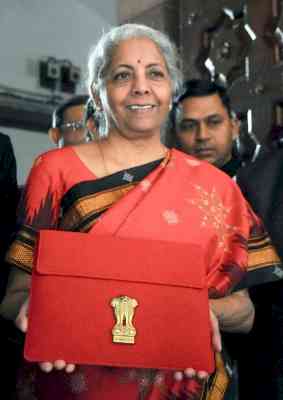Despite shadow of polls, FM steers clear of populism, focuses on growth (Opinion)
Overall, the Union Budget 2023-24 was focused on capex and investment, a right step in the nation's journey towards 'Amrit Kaal'.

Chennai, Feb 4 (IANS) Overall, the Union Budget 2023-24 was focused on capex and investment, a right step in the nation's journey towards 'Amrit Kaal'.
Despite being an election budget, it was mainly focused on long term growth of the country, while also managing to appease the populous expectations; without compromising on the fiscal deficit.
While the capex is heavily focused on infrastructure, sunrise sectors like renewable energy, space technology, electric mobility and alternative fuels have also received increased impetus.
The government has further promoted ease of doing business as more than 39,000 compliances have been reduced and more than 3,400 legal provisions have been decriminalised. This will boost local manufacturing and also help large giants to move their manufacturing base to India, promoting employment.
There are several opportunities that lie ahead for the Indian manufacturing, infrastructure and defence sectors and this budget has further enhanced the visibility in these sectors. We continue to focus on the sectors which are expected to contribute meaningfully to India's gross domestic product (GDP) growth and believe our portfolio is positioned in the right direction to take advantage of the long-term growth story of India.
This year's budget continued to favour infrastructure and capital formation, while managing to address consumption too. Broadly, we believe the budget touched three major themes:
For a third year in a row the government has continued to focus on infrastructure. This year the allocation of about Rs 10 lakh crore is about a 33 per cent increase from the last budget.
The government has maintained the fiscal deficit target of 6.4 per cent for FY23 and targeted 5.9 per cent for FY24. We also think the tax collection figures are reasonable and should be achieved. Considering the current run-rate of Rs 1.2-1.5 lakh crore of monthly goods and services tax (GST) collections -- the Rs 9.56 lakh crore figure mentioned in the budget should be achievable.
To boost immediate consumption and support the masses in an inflationary scenario, tax on income up to Rs 7 lakhs is foregone and due to the increased rebate, which shall increase their disposable income by Rs 380 billion.
Amongst the various announcements, below are some of the key highlights of the budget relevant to our focus sectors:
Railways saw the highest-ever capital outlay of Rs 2.40 lakh crore (up 49 per cent) and the major focus areas included electrification, new line addition & doubling of existing lines, gauge conversion, rolling stock, electric loco and Signaling and Telecom.
This is beneficial for rolling stock manufacturers, wire/cable manufacturers, locomotive manufacturers and component suppliers and entities involved in signaling.
In Auto, there has been an increase in the number of EVs targeted in the terminal year of FAME-2, resulting in a 78 per cent increase in allocation for FY24.
The allocation towards PLI scheme was at Rs 604 crore for Auto or Auto components and for ACC (cell-manufacturing). The budget also included scrappage as one of the purposes to allocate the 50-year interest free loans to states, scrapping old government vehicles of over 15 years.
There in a rise in effective customs duty (after surcharge) for imported vehicles on SKD basis by 4pp to 35 per cent, and imported vehicles on CBU basis by 6.4pp to 70 per cent. This increase in duty will encourage localisation.
Lithium-ion cell import duty of 5 per cent has been extended for one more year and the custom duty on capital goods for Li-ion cell manufacturing has been removed.
This should benefit the auto industry, increase localization of EV components and benefit OEMs and auto ancillary players. We also believe the infrastructure thrust should help revive the CV cycle.
Agriculture: The government had revised the BE 22-23 subsidy for urea and non-urea fertilizers in line with higher raw material prices. For BE 23-24, the subsidy allocation has been reduced by 22 per cent, which is in line with the downward trend of raw materials.
We believe the government will revise the subsidy allocation during the year, as per requirement. This will have a neutral impact on fertilizer companies.
Defence: The overall defence segment has not seen a substantial increase in allocations from the revised budget estimates. This is due to the large base and thrust already given to the sector in the last budget. Even at this the allocation towards defence is 13.18 per cent of the total budget. The total defence allocation of Rs 5.94 lakh crore includes Rs 1.38 lakh crore of defence pensions. While there was no specific announcement on the defence segment, the government still maintains its target of Rs 1.75 lakh crore worth of revenues by 2025.
The budget impact on this segment is neutral. But the thrust already provided by the government over the last few years should see the segment performing well.
Road and Metro: The road works segment has seen an increase in of 43 per cent in allocations from the revised budget estimates. And metros have seen an increase of 25 per cent.
Higher budgetary allocations were necessary to help the Ministry meet the 25,000-km road development target announced by the government in the 2022-23 Budget, amid rising interest expenses and increasing land acquisition costs. The government had set a target of 13,000 km of highway construction in FY2022-23, but the speed of construction was affected by unfavourable weather conditions. The Road Ministry is likely to complete the construction of 11,000 km of national highways in the current financial year. Out of the Rs 10 lakh crore allocated towards infrastructure about 25 per cent is allocated towards roads and highways.
This should have a positive impact on infrastructure companies specifically into roads, highways and metros. This should also benefit cement companies.
Power: The allocation to the Nuclear Power Corporation of India Limited was increased more than 43 per cent. This will increase the nuclear power capacity of the country and benefit the component suppliers.
Shipping: Capital Outlay on Inland Water Transport of Rs 992.46 crore (up 63 per cent). Coastal shipping will be promoted as an energy efficient and lower-cost mode of transport, both for passengers and freight.
Renewable Energy: Increase of about 50 per cent in the allocation of PM Kusum Scheme to Rs 2,000 cr and allocation of Rs 297 crore for National Green Hydrogen Mission will benefit the renewable energy and equipment manufacturers.
Piping: Cash Transfer of Rs 2.2 trillion to over 114 million farmers. The allocation for Jal Jeevan Mission has increased from Rs 600 billion to Rs 700 billion, an increase of 17 per cent over RE 22-24, to achieve piped water supply for households in India. This is a Positive for pipe manufacturers.
Banking: Capital investment outlay proposed to increase by 33.4 per cent to Rs 10 trillion, additional collateral free guaranteed credit of Rs 2.0 trillion to MSME and outlay for PM Awaas Yojana is being enhanced by 66 per cent to over Rs 790 billion. This will lead to a rise in credit demand benefiting banks.
(Pawan Bharadia is the Managing Director of Equitree Capital Advisors)


 IANS
IANS 








